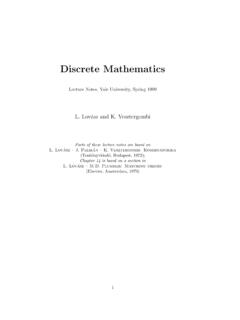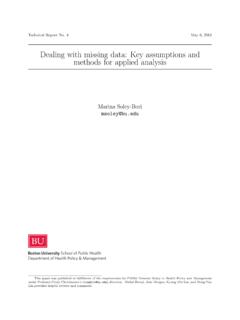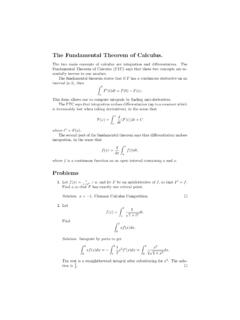Transcription of Lecture 3: Markov Chains (II): Detailed Balance, and ...
1 Miranda Holmes-CerfonApplied Stochastic Analysis, Spring 2019 Lecture 3: Markov Chains (II): Detailed balance , and Markov ChainMonte Carlo ( mcmc )ReadingsRecommended: Grimmett and Stirzaker (2001) ( Detailed balance ), ( mcmc ).Optional: Sokal (1989). A classic manuscript on Monte Carlo methods. Posted to Classes site. Diaconis (2009). An introduction to mcmc methods, that particularly discusses some of the theoret-ical tools available to analyze them. Posted to Classes site. Madras (2002). A short, classic set of notes on Monte Carlo Detailed balanceDetailed balance is an important property of certain Markov Chains that is widely used in physics ,X1,..be a Markov chain with stationary distribution . The chain is said to bereversiblewith respect to or to satisfydetailed balance with respect to if ipi j= jpji i,j.
2 (1)Equations (1) are called thedetailed balance do equations (1) represent physically? Suppose we start a chain in the stationary distribution, so thatX0 . Then the quantity ipi jrepresents the amount of probability that flows down edgei jin onetime step. If (1) holds, then the amount of probability flowing fromitoj, equals the amount that flows fromjtoi. Therefore, there is nonetflux of probability along the edgei jduring one time step, provided thechain is in the stationary that (1) isstrongerthan the condition that be a stationary distribution, that it solve the system = P. Sometimes this latter system is called the global balance equations. The global balance equationsinvolveskequations, whereas (1) involves|E|equations where|E|is the number of edges; often this growsask2and it is almost always larger thank.
3 The global balance equations say that the flow of probability isbalanced globally: at eachnode, the amount of probability flowing in in one step, equals the amount flowingout. The Detailed balance equations say the flow of probability is balanced locally: at eachedge, the amountof probability that flows across in one direction in one step, equals the amount that flows in the good analogy1comes from thinking about traffic flow in New York City and surroundings: let eachborough or suburb be represented by a node of a Markov chain , and join two nodes if there is a bridge ortunnel connecting the boroughs, or if there is a road going directly from one to the other. For example, the1 Thanks to Oliver B uhler for introducing this to Holmes-CerfonApplied Stochastic Analysis, Spring 2019node corresponding to Manhattan would be connected to Jersey City (via the Holland tunnel), to Weekawken(via the Lincoln tunnel), to Fort Lee (via the George Washington bridge), to Queens (via the Queensborobridge), that cars driving around represent little elements of probability.
4 The city is in global balance , or thestationary distribution, if the number of cars in Manhattan, and in all other nodes, doesn t change with is possible even when cars are constantly driving around in circles, such as if all cars leave Manhattanacross the Holland tunnel, drive up to Fort Lee, and enter Manhattan via the George Washington bridge. Aslong as the number of cars per unit time leaving Manhattan across the Holland tunnel, equals the number perunit time entering Manhattan via the George Washington bridge, the number of cars in Manhattan doesn tchange, and the system can be in global city is in Detailed balance , only if the number of cars that leaveseach bridge or each tunnelper unit time,equals the number that enter thatsamebridge or tunnel.
5 For example, the flux of cars entering Manhattanthrough the Holland tunnel, must equal the flux of cars exiting Manhattan through the Holland tunnel,and similarly for every other bridge or tunnel. Not only does the number of cars in Manhattan remainconstant with time, but the fluxes of cars across each single bridge or tunnel separately must be equal in we can tell directly from the graph structure of a Markov chain , whether it is possible for it to bein Detailed balance . Here is a chain that does not satisfy Detailed balance , no matter what probabilities areput on the (directed) edges:There must be a net flux of probability through the red edges, because probability cannot move along themin the opposite balance is a powerful concept, partly because it gives a tractable way to find a stationary distribution,or, as we ll see in a couple of sections, to construct a system has the desired stationary P be the transition matrix of a regular Markov chain Xn, and suppose there exists a distri-bution such that ipi j= jpjifor all i,j S.
6 Then is a stationary distribution of the chain , and that satisfies the conditions of the theorem. Then i ipi j= i jpji= j ipji= = P, so is a stationary distribution. By definition,Xnis reversible with respect to .2 Miranda Holmes-CerfonApplied Stochastic Analysis, Spring 2019 This theorem is a really useful way of finding the stationary distribution, since it is often easier to solve thelocal equations (1) than the global ones. Here is an example to illustrate (Ehrenfest model of diffusion).Recall the example introduced in Lecture 2, where we have acontainer with a membrane in the middle and a total ofmparticles distributed in some say between the leftand right sides of the container. At each step we pick one particle at random and move it to the other # of particles in the left side at timen.
7 ThenXnis a Markov chain , with transition probabilitiespi,i+1=1 im,pi,i 1=im. What is the stationary distribution of this chain ?Let s look for a solution that satisfies (1). If we find a solution, we know that it is stationary. And, wealso know it s the unique such stationary solution, since it is easy to check that the transition matrixPisregular. Notice that all edges are between nodesi i+1 fori=0,1,..,m 1 so we only have to solve theequations ipi,i+1= i+1pi+1,i i(1 im)= i+1(i+1m) i+1= im ii+ way to solve this is to (temporarily) set 0=1, and then solve recursively for 1, 2,.. It is not hardto derive the (again, temporary) formula i=(mi). Now normalize to make it a probability distribution, toobtain i=12m(mi),i=0,1,.., the stationary distribution for the number of particles in one side of the container is Binomial(m,12),which is very close to a normal distribution whenmis you just guessed the formula above, and then checked it satisfied the Detailed balance equations, this wouldalso be a valid way of showing it s the stationary is a Markov chain that satisfies the Detailed balance equations calledre-versible?
8 Recall the example in the Homework where we ran a chain backwardsin time: we took a regular Markov chain , started it in the stationary distribution,and let it run, to getX0,X1,X2,..,XN, each of these with distributionXi .LetYn=XN nbe the reversed chain . Then, you showed thatY0,Y1,..,YNis aMarkov chain with transition probabilitiesP(Yn+1=j|Yn=i) = j iPji. The tran-sition probabilities forYnare the same as those forXn, exactly whenXnsatisfiesdetailed balance ! Therefore, the chain is statistically indistinguishable whetherit is run forward or backward in balance is a very important concept in physics and chemistry. If a system satisfies Detailed Balance, then it is called anequilibrium system, or sometimesreversible in equilibrium.
9 Otherwise, it is called anon-equilibrium a system does not satisfy Detailed balance , there are non-zero fluxes insteady-state, then the system must have forces acting on it. This makes statistical mechanics vastly morecomplicated. Most of statistical mechanics has been developed to deal with equilibrium systems, but it is2 Being an equilibrium system is dfferent from being in equilibrium. A system is in equilibrium if its probability distribution is thestationary distribution, it is in steady-state. A system is an equilibrium system if, in addition to being in equilibrium, it satisfiesdetailed balance with respect to its stationary Holmes-CerfonApplied Stochastic Analysis, Spring 2019only now being developed for non-equilibrium you like fluids, one way to picture Detailed balance is to imagine a turbulent fluid in a box.
10 If the fluid isforced and dissipated isotropically, ( by some external heat bath), then there should be no mean flow, onaverage. However, if we stir the fluid in one direction, then even if it is very turbulent there will be a meancirculation in the are some examples of physical systems that do / do not satisfy Detailed balance : Detailed balance particle diffusing in a fluid particle binding and unbinding to a receptoron a cell Ising model with dynamics above ideal gas in an insulated box system in contact with one heat bath covered, insulated coffee cup with liq-uid/vapour equilibrium crystal with no external forcesNo Detailed balance self-propelled ( swimming) particle molecular motor atmospheric circulation patterns plasma with non-Maxwellian velocities system in contact with two heat baths, at dif-ferent temperatures snowflake melting in a coffee cup sheared Spectral decomposition for a Markov chain that satisfies Detailed balanceIfPsatisfies Detailed balance , then it can be symmetrized by a similarity transformation.


















